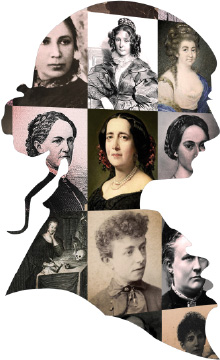Marija Popović Milutinović
1810–1875| Pseudonyms | Punktatorka |
|---|---|
| Spouse | Sima Milutinović Sarajlija |
| Date of birth | 1810 |
| Date of death | 1875 |
| Web address |
Personal situation
Marija Milutinović Punktatorka was born in 1810. She was born and went to school in Buda. Her love of literature is what brought Sima Milutinović Sarajlija and Marija Milutinović together. They got married on May 4, 1838. Marija made a comment on her decision to marry: “I am tired of being dependent on other people’s whims. As a married woman I will not be forced to work for others. Unless, God forbid, an unpredictable disaster happens.” She gave birth to a son named Dragutin on November 22, 1840.
After her husband died at the end of 1847, Marija Milutinović lived with her child on a 200-forint state pension.
She was well ahead of her time – Anka Obrenović noted in her diary that Marija was the first woman to use an iron in Belgrade in 1838. Her home in Belgrade was a gathering place for people coming from Vojvodina. Katarina Ivanović, the first woman to become an academic painter in Serbia, lived in her house during her stay in Belgrade.
Marija Milutinović died in Belgrade in 1875. A farewell to Marija in the magazine Javor (The Maple) says: “The Lord be with you, honorable Punktatorka! May your eternal sleep deliver you from a life of labor.”
Written by Nena A. Vasojević
Translated by Damjana Petronijević
| Place of birth | Budim |
|---|---|
| Place(s) of residence | Hungary and Serbia |
| Place of death | Beograd |
| Nationality | Serbian |
| First language(s) | Serbian |
| Marital status | Married |
| Number of children | 1 |
| Name(s) of children | Dragiša |
| Gender of children | M |
| Social class | Upper class |
| Education | University education |
Professional situation
Marija Milutinović became a teacher in 1847. In Belgrade, she managed a private elementary school attended by daughters of numerous renowned families. She worked as a teacher in a state school next to the Cathedral Church of St. Michael the Archangel in Belgrade in 1849. In 1852, she was promoted to senior teacher and taught 15 senior students.
Marija practiced law as well. However, she represented only the poor pro bono and did not make any money. Jakob Ignjatović remarked: “Sima’s wife is a gifted woman. Before Sima died she started practicing law. She defended many lawsuits successfully. She knows the law inside out, when she works, she is precise, her writing is lively, with intensely convincing representations.”
Vuk Stefanović Karadžić held Marija in high regard. Whenever he visited Buda, he sought her company. In his letters, she was described as a well-educated girl and referred to as “Pretty Mary from Buda”. She preserved Luka Milovanović Georgijević’s poetry by giving the poems to Vuk Stefanović Karadžić, who published them.
Learned young people from Pest gathered around this exceptional Serbian woman in order to gain knowledge and discuss the latest literary phenomena. Đorđe Dimitrijević (Rabadžija), Lazar Lazarević, Jovana Raić, Aleksandar Budimirović, Avram Branković, and Dimitrije Neofitiović were among this cultured youth. At the time, Sima Miltinović Sarajlija’s poem Srbijanka (The Serbian Woman) attracted the attention of literary and sophisticated circles. Marija and the people around her devoted a lot of attention to the interpretation of the poem. Marija modified Srbijanka by adding certain symbols, puncta, which helped the readers understand the poem in the right way. Sima praised Marija’s modification publicly. They met in 1836 and that is when he nicknamed her “Punktatorka” (Serbian for ‘she who adds puncta’). From then on she became known as Punktatorka – a nickname she used herself in her signature.
Marija spoke German well. In 1837, she translated a historical collection which Sima sent her from Leipzig into German at his request. In a letter dated March 16, 1837, she wrote that even though she did not derive pleasure from writing, she would do it for the sake of his love. In this letter she also asked for the Serbian-German grammar by Jacob Grimm.
Edited by Nena A. Vasojević
Translated by Damjana Petronijević
| Profession(s) and other activities | embroiderer (and other “travaux de dames ») and teacher/governess |
|---|---|
| Language(s) in which she wrote | Serbian |
Works by this author
Articles and other similar texts
Reception
Reception after death
- Marija Milutinovićka "Punktatorka" (1875)
- Vukova prepiska. Knj. 6 (1912)
- Memoari : rapsodije iz prošlog srpskog života (1966)
- Sima Milutinović - Mariji Popović (1970)
- Dragiša Milutinović - Mariji Milutinović (1970)
- Srpske pesnikinje XIX veka (1981)
- Eseji o srpskim pesnicima (1981)
- Znamenite žene Novog Sada [Knj.] 1 (2001)
Authors read by this author
* Only authors in Knjiženstvo DB are shown



